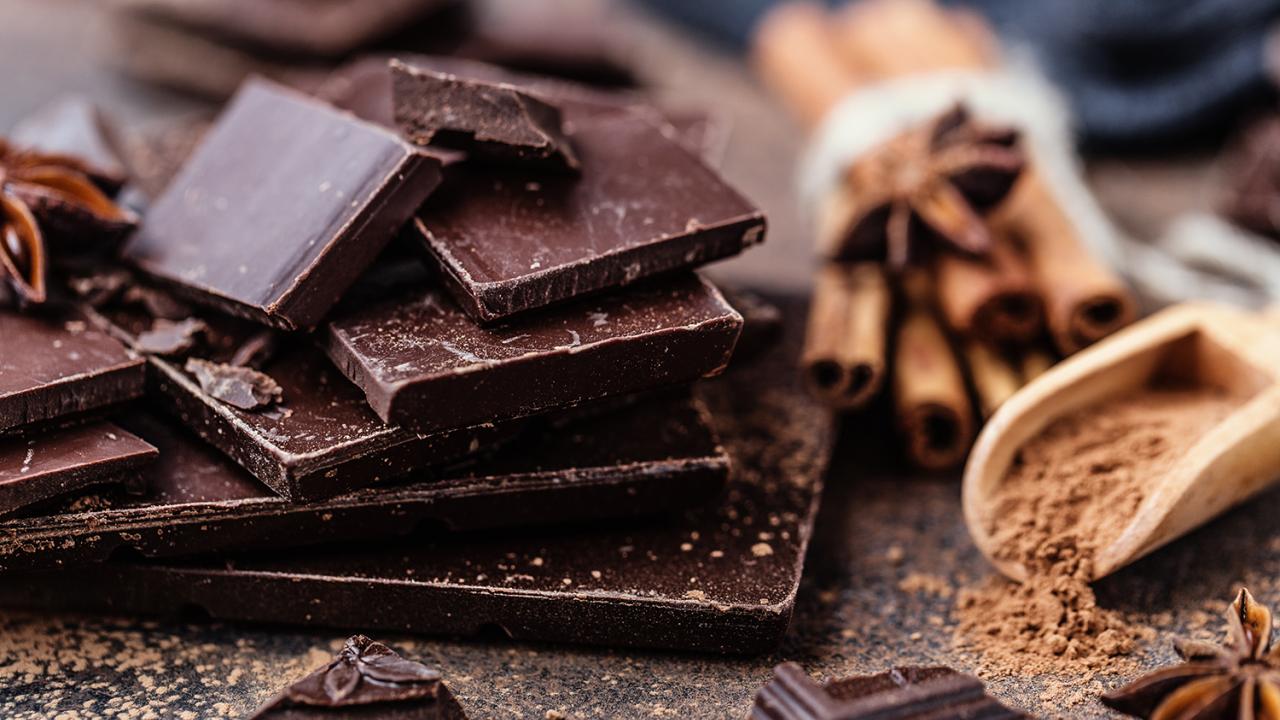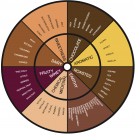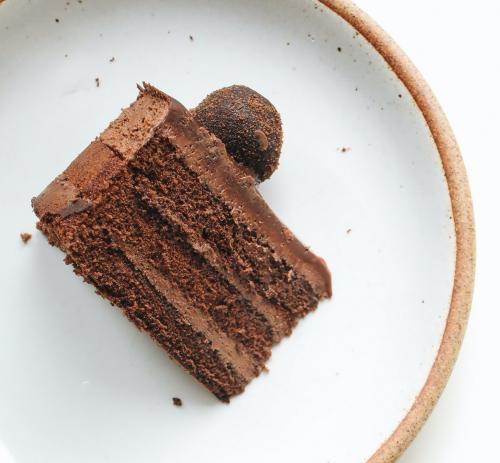
Q&A: The Many Flavors of Chocolate
On February 3, 2021, Thalia Hohenthal and Rebecca Kuehn from Guittard Chocolate joined Dr. Selina Wang from the UC Davis Olive Center for Sips and Bites: The Many Flavors of Chocolate. Many who joined asked our presenters questions that were not answered during the allotted time, so we're posting them here. To watch the full presentation, visit our Youtube channel. Please navigate these general topics.
- About Chocolate
- Working With Chocolate
- Sourcing and Terrior
- About Guittard Company
- Thalia's Vegan Chocolate Cake Recipe
About Chocolate
1. I am reading that there is an excess of cocoa supply in the world. Has consumption fallen due to Covid?
COVID has increased the consumption of chocolate and especially home baking. You are correct that there is growth in the tonnage and yet there is also an increase in demand. So far, so good. This is not the latest report but it is from a reliable source: Global Market Report: Cocoa
2. Do you have a favorite "history of chocolate" fact, especially as it relates to it Mexican origins?
I have an opinion that it was the best food the Europeans encountered when arriving in the native growing regions. Chocolate was used chocolate ritually and included alcohol fermentations that paralleled the Christian ritual use of alcohol. Cocoa beans were used as currency in Mayan culture.
Flavor Characteristics of Chocolate

Guittard was the first to develop one decades ago after attending a business dinner meeting where Ann Noble was the speaker, presenting her wine aroma wheel. Now the industry has worked together to harmonize terms and create a wheel.
3. Flavonoids have been touted as one of the healthy aspects of chocolate. Do the flavonoids also contribute to the flavor?
Yes, astringency and bitterness.
4. Does white chocolate actually contain cacao?
The source of "cacao" is the cocoa butter which is the naturally occurring fat in the cocoa beans. We mechanically separate the cocoa butter from the fluid bitter chocolate and capture it to make other products, like white chocolate and other sweetened chocolates.
5. What is white chocolate?
White chocolate is defined in Code of Federal Regulations Title 21. It states that there must be 20% cocoa butter min, the right types of milk ingredients, and sweeteners. Basically, it is milk chocolate without the brown part - chocolate liquor (unsweetened chocolate).
6. How long can you use chocolate chips passed their best by used date if stored in a cool dark place?
If stored as you say, and away from any other strong odors or temperature fluctuations or pests, we state a two year shelf life. I've tasted much older chocolate than that will good results, but not always.
7. What are the spices that go best with chocolates? Would there be a different best spice for hot chocolate, chocolate bars, or chocolate pastries?
In the right spirit, anything can be successful. Of course, cinnamon in chocolate chip banana bread, ancho chili in hot chocolate - using roasted, ground mace to sweeten! Pan-toasted star anise infused into cream to make a chocolate truffle or mousse, candied orange or grapefruit bits cured with clove set on the surface of cooling dark chocolate medallions, almond extract dripped into chocolate steamed milk - frothed into espresso.
Working With Chocolate
1. Do chocolate chips have something added in the formula to help retain the shape when baked or are the formulas the same as the chocolate wafers and bars of the same chocolate type?
Chocolate chips have more solids and less fat (cocoa butter) or fluid phase than wafers or bars. In liquid, tempered chocolate, the ratio of total fat to solid fraction, along with the particle size distribution and use of lecithin will largely predict the rheology of the chocolate at the point of depositing. So, we control these factors closely, formulating with lower amount of cocoa butter and tempering to achieve the desired chip shape. Wafers and bars have a higher ratio of total fat to solid fraction as compared to cookie drops so they flow more easily when melted and tempered, making them more suitable for tempered coating applications.
2. What is the best way to thin melted chocolate so I can dip candied orange peel in it? It seems to thick if I just melt it.
First, select the right chocolate for the product you want to make. We have five items that would each taste great - 38%, 66%, 74% baking wafers in 12 oz pouches, and 64% and 70% baking bars in 6 oz boxes. Tempering is described in the next question. Many customers try to use melted chocolate chips for dipping projects. This is not advised because the lower level of cocoa butter used to achieve the shape is not adequate for fluidity after tempering to permit coating. Tempered chocolate chip chocolate is pasty in it's constancy.
3. What’s the temper temperature for the 100%?
Tempering the 100% is the same as tempering our other dark chocolates, based upon the crystallization of the cocoa butter. Melt to 120F, cool to 83F with stirring, rewarm to 88-90F. Alternately, stir 1/3 working weight of broken pieces into 2/3 of working weight of chocolate that has been warmed to 100F. With no further heating or auxiliary cooling other than room temperature, this will produce fluid, tempered chocolate when at 88-90F
4. When melting/tempering chocolate for candies, is there a difference between using chocolate chips and using a chocolate bar?
Yes, the chocolate chips do not have enough cocoa butter to allow for proper flow, it is almost pasty when melted and tempered. Better to use wafer or bar pure chocolate.
5. What is the best way to melt chocolate at home?
I like to use a Pyrex glass measuring cup with about 1/2 cup of working chocolate. In a microwave, it melts in about 30 seconds or a second pulse of about 10-20 seconds. Double boiler over slowly simmering water is good too, but it melts very rapidly and sometimes gets too hot.
Sourcing and Terroir
1. Where do you source your chocolate?
The cocoa beans are selected from a set of growing regions that give us the several 'house blends' we use in our chocolate making and a few unique growing locations for our single origin chocolates. West Africa and South America and some South Pacific Islands. We do the roasting in Burlingame, CA to have full control over the flavor quality we want to achieve.
2. Where are the beans from for the 100% dark chocolate? What kind of cacao beans are they?
Mostly South American flavor beans - rich and complex in chocolate flavor.
3. Does terroir impact the flavor of the cacao?
Yes. The cocoa plants draw up nutrients in different ways depending upon the relative amounts found in particular soils, leading to all sorts of expressed differences.
4. Does the dairy component, in particular the soil and water the cattle would consume, have an effect?
Yes! Milk flavor quality is a huge driver for the finished flavor of a milk chocolate. It is hard to come by in the commercial quantities sometimes. So there is a lot to developing the supply chain. Very interesting area. Grass fed milk is like riding the rapids, it can be very risky to the outcome of the final chocolate flavor, but very satisfying, too.
5. Are there seasonal variations in flavor?
The small crop, as it is called, versus the large crop, will tend to have lower moisture beans which can result in the need for differences in roasting parameters - this is done to standardize the final flavor, whatever the season.
About Guittard
1. Where can you find Guittard Chocolate?
Safeway, Mollie Stones, and a variety of other grocery stores. Online, worldwidechocolate.com, chocosphere.com may provide some items in household quantities. Look for the "Apeels" brand name for the milk, dark, and white flavored apeels.
2. How do you choose which products to sell in grocery stores? We love your creme francais white chocolate wafers for baking, but haven’t seen them in small packages (only 3 kg online) in the last few years.
Yes, good question. That is a very expensive product to make and it has a very short shelf life, so it is rather fragile in terms of delivering guaranteed great taste. So after about 10-15 years we discontinued it because not enough people were buying it. However, we have continued to have strong sales in our more robust Vanilla Milk Chip, white compound baking chip (compound means made mostly with palm kernel oil). Creme francais White Chocolate is still available for professionals in 3kg and larger packs. Usually we select products for the grocery store that fill a specific purpose and are an outstanding improvement over other products that might be used for that purpose.
3. How many pounds and kinds of chocolate do you make per year?
We have about 300 items and we make tons and tons. We have a technical team that I am very proud to be part of with all college graduates holding scientific degrees. It is very enjoyable to have a pot luck with this varied group! This is a general answer because I do not actually know because that is confidential info for the family.
4. What beans do you use for your cacao nibs?
We use our classic blend of West African and South American beans for our nibs that we sell to our professional users. So the flavor of our nibs will remotely resemble our semisweet chocolate flavor.
5. Why are the semisweet chocolate chips smaller than the milk chocolate ones?
At the time we introduced the maxi milk chocolate chip to grab attention as we entered the age of super-sized food portions.
Thalia's Vegan Chocolate Cake Recipe
1. Preheat oven to 350F. Prepare 2, 13” x 18” sheet pan (aka jelly roll pan, or bun pan) with parchment lining, foil, or pan spray or oil.
2. Combine these first 6 dry ingredients together:

- 6 cups All-purpose Flour, good quality, like Trader Joe’s or Bob’s Four Mill (because it tastes cleaner and sweeter, no bitter after taste like some)
- 1 ½ cups Grand Cacao Drinking Chocolate, Guittard
- 6 tsp Baking Soda
- 3 tsp Salt
- 3 ¼ cups Coconut Sugar
- 3 cups chopped high quality, block Guittard's Dark Chocolate or Semisweet Chocolate Baking Chips (best with a small amount of chopping but not necessary)
3. Separately, combine these 4 wet ingredients together:
- 6 Tbsp Balsamic Vinegar (high quality, like Alidoro from Dean's Market in San Mateo)
- 1 Tbsp Vanilla extract
- 1 ½ cups Grapeseed oil
- 4 cups cold water
4. Add wet ingredients to dry ingredients. Stir well from the center outward toward the edge of the bowl until all ingredients are well incorporated. Fill pans. Bake 20-30 min until underdone. Cool.
5. Serve with a variety of sides to be used as toppings: chocolate ganache (equal parts dark chocolate melted with cream or milk), raspberries, bananas sautéed in sugar and butter to caramelize, whipped cream, chocolate sprinkles, chopped nuts, sliced peaches, Nutella, or etc.
